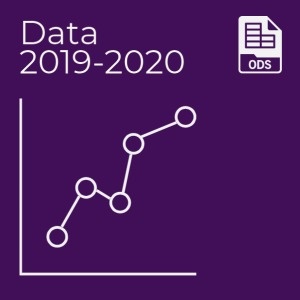Learn Welsh Statistics 2019-2020
Learn Welsh programme data is managed by the National Centre for Learning Welsh.
A central database collates information on all learners as they register online to follow a course. This information includes details about the learner (e.g. name, address, date of birth) and the course (e.g. level, location, learning intensity).
The data collected by the Centre differs to the data collected for the sector in the past. The method of recording the data is also different.
2019-2020 Data reflects the sector's activity during the pandemic. Activity was impacted during March 2020 as face-to-face teaching came to an end. This impact is likely to continue to be reflected in 2020-2021 data. The funding for the Work Welsh programme was significantly reduced in April 2020, therefore it was not possible to continue to provide intensive courses at all levels but the courses at Entry level were increased.
Publishing 2019-2020 Data
This data is for the 2019-2020 academic year.
- These statistics relate to all courses that ended between 1 August 2019 and 31 July 2020.
- 2017-2018 was the national baseline, we can therefore make year by year comparisons thereafter.
- Work Welsh courses run from April to March. For the purpose of these statistics, only courses that have come to an end by July 2020 have been included.
- The national Work Welsh project is included fully for the first time in 2019-2020.
Number of unique learners

The number of unique learners counts every learner only once, regardless of the number of courses they have attended during the year.
- In 2017-2018, there were 12,680 unique learners.
- In 2018-2019, there were 13,260 unique learners.
- In 2019-2020, there were 17,505 unique learners, an increase of 32% compared to 2018-2019.
- The national Work Welsh project is included fully for the first time in 2019/20.
Number of learning activities

Learners can attend more than one learning activity at various levels and intensities. For example, a single learner can attend a 170 - 259 hour course at Entry level and an additional 'per hour' course at Foundation level during the period in question. This is considered as two learning activities.
- 2019-2020 learners attended 30,115 learning activities, an increase of 48% when compared to 2018-2019.
- The national Work Welsh project is included fully for the first time in 2019/20.
Learning levels

Courses are offered at five levels within the Learn Welsh Programme.
- In 2017-2018 51% were at Entry level. Entry is the first learning level for beginners. 18% were at Foundation level with 31% at Intermediate or Advanced levels (including Proficiency).
- In 2018-2019 51% were at Entry level. 17% were at Foundation level with 32% at Intermediate or Advanced levels (including Proficiency).
- In 2019-2020 68% were at Entry level. 11% were at Foundation level with 19% at Intermediate or Advanced levels (including Proficiency).
- The funding for the Work Welsh programme was significantly reduced in April 2020, therefore it was not possible to continue to provide intensive courses at all levels but the courses at Entry level were increased.
Age of learners

The age of learners is calculated from the first day of the academic year. For 2019-2020, the age of the learner is calculated from 1 August 2019. This is the first year that the age of learners are published.
- In 2019-2020 there are 15,015 learners within the working age group (16-64 years old), which is 86% of all learners.
- The learners within the age group 16-24 has increased 5% compared to 2018-2019.
